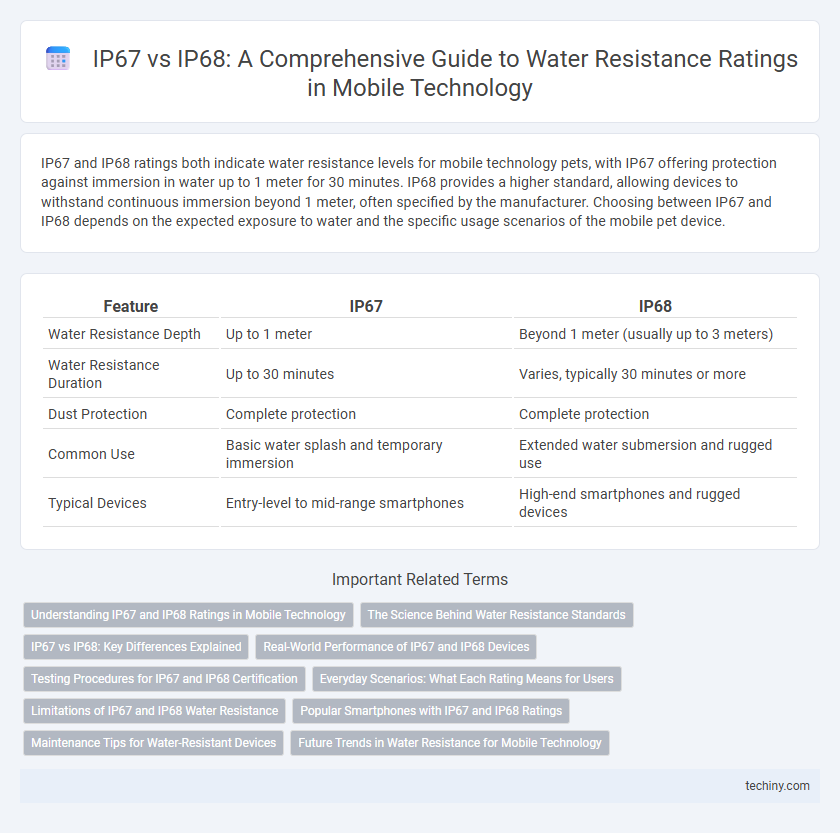IP67 and IP68 ratings both indicate water resistance levels for mobile technology pets, with IP67 offering protection against immersion in water up to 1 meter for 30 minutes. IP68 provides a higher standard, allowing devices to withstand continuous immersion beyond 1 meter, often specified by the manufacturer. Choosing between IP67 and IP68 depends on the expected exposure to water and the specific usage scenarios of the mobile pet device.
Table of Comparison
| Feature | IP67 | IP68 |
|---|---|---|
| Water Resistance Depth | Up to 1 meter | Beyond 1 meter (usually up to 3 meters) |
| Water Resistance Duration | Up to 30 minutes | Varies, typically 30 minutes or more |
| Dust Protection | Complete protection | Complete protection |
| Common Use | Basic water splash and temporary immersion | Extended water submersion and rugged use |
| Typical Devices | Entry-level to mid-range smartphones | High-end smartphones and rugged devices |
Understanding IP67 and IP68 Ratings in Mobile Technology
IP67 and IP68 ratings define the level of water and dust resistance for mobile devices, with IP67 offering protection against immersion in up to 1 meter of water for 30 minutes and IP68 providing enhanced protection, typically allowing immersion beyond 1 meter, often up to 1.5 meters or more depending on manufacturer specifications. These ratings are crucial for users who require durable smartphones capable of withstanding accidental spills, rain, or brief underwater exposure. Understanding the specific testing conditions and manufacturer interpretations of the IP68 standard helps consumers make informed decisions about the durability and suitability of mobile devices for their lifestyle.
The Science Behind Water Resistance Standards
IP67 and IP68 ratings define the degree of protection against water ingress based on international IEC 60529 standards, where IP67 ensures complete dust protection and immersion in water up to 1 meter for 30 minutes. IP68 provides a higher level of water resistance, allowing devices to withstand continuous immersion beyond 1 meter, typically up to 1.5 meters or more, depending on manufacturer specifications. The technology behind these ratings involves advanced sealing techniques, such as gasket seals and water-resistant adhesives, which prevent liquid penetration, preserving device functionality under specified conditions.
IP67 vs IP68: Key Differences Explained
IP67 offers water resistance up to 1 meter for 30 minutes, while IP68 provides deeper submersion protection, typically beyond 1 meter and for longer durations depending on manufacturer specifications. The key difference lies in IP68's ability to withstand continuous immersion, making it more suitable for prolonged underwater use. Both ratings indicate dust-tight protection, but IP68 ensures enhanced durability in wet environments.
Real-World Performance of IP67 and IP68 Devices
IP67 devices offer water resistance up to 1 meter for 30 minutes, suitable for accidental splashes and brief immersion. IP68 devices provide enhanced protection, typically supporting depths beyond 1 meter and longer submersion times, making them ideal for swimming or underwater photography. Real-world performance depends on manufacturer specifications, with IP68 rated phones generally delivering greater durability in wet environments.
Testing Procedures for IP67 and IP68 Certification
IP67 certification requires devices to withstand immersion in up to 1 meter of water for 30 minutes under controlled testing conditions. IP68 certification involves testing beyond IP67 standards, typically requiring submersion beyond 1 meter, often up to 3 meters, for durations specified by the manufacturer. Both testing procedures assess resistance to dust ingress and water exposure but differ in immersion depth and duration to ensure varying levels of water resistance.
Everyday Scenarios: What Each Rating Means for Users
IP67 rated mobile devices can withstand submersion in up to 1 meter of water for 30 minutes, ideal for accidental drops in puddles or brief exposure to rain. IP68 devices offer enhanced protection, typically allowing submersion beyond 1 meter (often up to 1.5 meters) for 30 minutes or more, making them suitable for swimming or extended underwater use. Understanding these ratings helps users select devices that match their lifestyle needs, ensuring durability during common daily water exposures.
Limitations of IP67 and IP68 Water Resistance
IP67 water resistance protects devices from immersion in up to 1 meter of water for 30 minutes, but it is limited against prolonged submersion and high-pressure water exposure. IP68 offers enhanced protection, typically allowing immersion beyond 1 meter and for longer durations, yet it still has limitations against saltwater corrosion and extreme water conditions like high-speed jets. Both IP67 and IP68 ratings do not guarantee complete immunity to water damage over time, especially with wear and tear affecting seal integrity.
Popular Smartphones with IP67 and IP68 Ratings
Popular smartphones with IP67 ratings include the Apple iPhone 7 and Samsung Galaxy S8, offering protection against dust and water immersion up to 1 meter for 30 minutes. Devices like the iPhone 13 Pro and Samsung Galaxy S21 Ultra feature IP68 ratings, providing superior water resistance up to 1.5 meters or more for 30 minutes, enhancing durability during accidental submersion. Choosing between IP67 and IP68 smartphones depends on the required water resistance level for daily use and environmental exposure.
Maintenance Tips for Water-Resistant Devices
IP67 and IP68 ratings indicate different levels of water resistance, with IP68 offering protection against continuous immersion beyond 1 meter and IP67 protecting against immersion up to 1 meter for 30 minutes. To maintain water-resistant capabilities, regularly inspect and clean device seals, avoid pressing buttons underwater, and promptly dry the device after exposure to liquids. Proper maintenance extends the lifespan and performance of mobile devices with IP67 or IP68 certifications, ensuring reliable protection against water damage.
Future Trends in Water Resistance for Mobile Technology
Future trends in water resistance for mobile technology indicate a shift from traditional IP67 and IP68 ratings towards more advanced solutions like seamless waterproof coatings and self-healing materials. Innovations in nano-coating technologies aim to provide deeper submersion capabilities beyond the 1.5-meter limit of IP68, enhancing durability in extreme environments. Integration of smart sensors to detect water exposure and dynamically activate protective barriers is also expected to revolutionize mobile device water resistance.
IP67 vs IP68 (water resistance) Infographic

 techiny.com
techiny.com